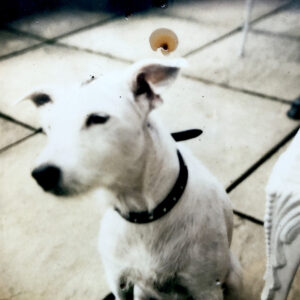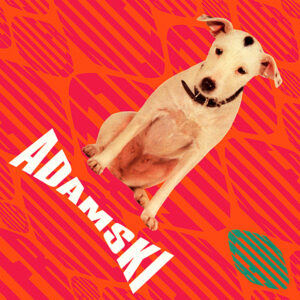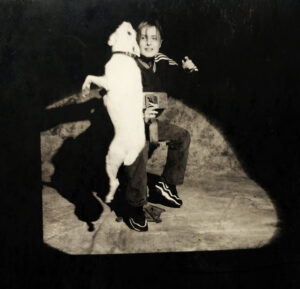From Adamski record sleeve star to Mark Jenkin muse, A Man Called Adam’s Sally Rodgers shares the story of her little white dog; famous, funny and sharp as a tack.

Back in the early 90s, when me and Steve were making our first album, we’d lived in this fancy little block of duplex houses in Camden. There was a vinyl mastering studio and some TV production places downstairs – we used to see politico Andrew Rawnsley going in and out – and up a floor, it opened out on to a courtyard with nice planting that was lined with trendy little 2 bedroom houses. It was boom time for the music industry – the money from CD reissues of the vinyl canon was still flowing – every fucker had a record deal – and back then Camden was where it was all happening. After several years on the dole (an arts bursary we always called it) we now had money for a nice place like this and several other bands and well-known musicians also lived there. Our jokey name for it was ‘Popstar Parade’. We used to see Miles Hunt from the Wonderstuff (occasionally in his pith helmet) in the lift. D n B superstar Adam F lived in the house opposite, and Adamski and his little white dog lived in the next block along.
We knew Adamski a little, we’d played on the same bills as him, had always admired his straight-out-of-the box ferocity (on a 60K rig he was mind-blowing), and his adapted 909 that gave him live sequencing super-powers. We all used to eat in a cous cous place in Kentish Town called The Little Prince that his then-manager owned (or maybe co-owned) and over time we became good friends. He released ‘Killer‘ during that period and suddenly he became really famous, and I mean tabloid stories and strangers-shouting-at-you-in-the-street type famous. He was, inevitably, insanely busy and we used to look after his dog Discord sometimes when he was away or otherwise engaged.
He told us he’d bought her as a puppy off a bloke in a pub and from that day she’d gone everywhere with him. In his early, punk-rock rave days his stage name had been Diskord Datkord and Dis had been part of the act – a bit Julian Clary and Fanny the Wonder dog except, he told us, Dis used to wander onstage and ‘do a shit’ while he was playing. On the rave scene he used to arrive in a field somewhere, let her off her lead and then just call her when he was leaving the next morning. In the interim she’d roam around the site getting pets and fuss from all the loved-up Acid Teds. When ‘Killer’ came out she featured on the sleeve and magazine covers, and they were always doing photo and video shoots together. We’d visit him in the studio and they were like an old married couple arguing – her barking at him, him shouting back at her. When he and his partner had a baby girl we looked after Dis more and more. She was part Fox Terrier, part Jack Russell and that 100% Terrier temperament can be tricky with little ones. One day when we caught the baby (Bluebell) and Dis sharing a rusk together on the living room floor and around then it was decided that Dis should come and live with me and Steve permanently. And we loved that dog like we loved Adam. They were actually very alike. Famous and funny and sharp as tacks.

And so, Dis entered the second phase of her life. A quieter, more conventionally dog-like existence with me and Steve sharing the care of her. By this time, we’d been dropped from our label and had started our own label, Other, with an old friend from Teesside, Jaffa. He was a sleeve designer and had a space above his design studio in Gospel Oak where we set up our studio and went every day to make music. She was a seasoned studio dog, but it was meters from Hampstead Heath and we took her for long walks there every day. She loved to swim, play ball and drag enormous sticks around. At home she had her basket and her toys, set mealtimes – just a nice doggy life. She was still feisty and funny though. She hated Steve’s girlfriends and loved my boyfriends. With that distinctive black spot between her ears she’d get recognised in the streets around Camden and Japanese girls would shriek with delight and ask for photos with her (it was the pre-selfie era). We’d bring her up to my family in the North East and she loved the huge expanses of Redcar beach. I’d always fantasised about swimming in the sea with her, so we took her on a big family holiday to Kerry in Ireland. I got to live that fantasy and it was a wonderful trip until she suddenly became very ill. Me and Steve took her to some rural vet who said she had algae poisoning and if she wasn’t better in 24 hours he’d come and put her down. I fainted outside the surgery and we stayed up all night, spooning drops of water in to her mouth. The next morning, we just bundled her in to the car and took her home. She recovered and lived another 2 years after that. We felt lucky to have that extra time with her. I know everyone says this, but she really was a special dog and we were heartbroken to lose her.
But time moves on and life happened. We moved East when Camden became too expensive for independents like we now were, and eventually we left London altogether. In the early noughties London was flooded with cocaine (there’s a Brinks Matt connection apparently), and the music industry was battling new tech and falling revenues. It was pretty grim. For a few years we’d done writing sessions, a week here, a week there, in a rented house near Zennor in Cornwall and we’d fallen in love with the place. So, when the opportunity arose, we packed up and bought a modest house near Penzance with a big outbuilding where we could make a racket. As with our time in Gospel Oak (where we’d been immersed in a lovely creative community – we made ‘Estelle’ and ‘Easter Song’ there and compiled an album for Heavenly of Nu British House with our friends called High in a Basement) we found a rich seam of people in Cornwall doing and making wonderful art. Designers and Interior designers like Dion Star and his wife Helena, and Mark Jenkin, a passionate film maker teaching at the University in Falmouth. It feels as though you are very time-rich when you live in the countryside and in our ‘Big Shed’ studio we pushed the limits of our own practice, experimenting with sound art and audio-visual work. We did museum sound, the odd installation piece, and worked with Mark on the soundtrack for his first feature film Bronco’s House.
When we finally left Cornwall 10 years later, we had the mammoth job disposing of all the mad music-making, sound-producing shit we’d accumulated over the years. Amongst the floppy disks, tape machines, old gramophones, 2 inch tapes and broken keyboards was a box of Super 8 we’d shot many years earlier and never developed. In his tiny studio in Newlyn, Mark obsessively hand-developed such film and when we left in 2014, we handed him a box with a dozen or so spools of film and said, ‘if you ever get around to developing any of it feel free to use the footage, just send us a copy’. That was it. He went on to make BAIT, Enys Men and all the stunning work he’s done since and we did what we do. Then about 6 months ago Mark called me and asked about a black and white film he’d finally developed of a little white dog running on a beach.
He sent us the file but asked if he could record our reaction to seeing it for the first time. We left it zipped on the desktop till the next day (which was tough) and then in a Zoom call we all watched it together. And there she was, running toward the camera, free and wild and alive for the first time in 25 years. It was, as they say ‘totes emosh’. Because dogs, or any animal you share your life with, are not just pets. There’s a Hawaiian word for pet owner, ‘Kahu’, which means roughly ‘beloved attendant’ of something precious, and I like that. These precious beings offer us love and map out our lives with their benign presence. And while Dis had become a memory, a photo on a cork board in the kitchen, a collar in the cupboard under the stairs, here she was again, zooming around, getting in to trouble, pulsing with life.

Dis and Sally
Mark’s film was commissioned by The British Film Institute for their Film on Film Festival this summer. It’s about his film making practice and his all-consuming love of the analogue process – the light, the sprockets, the chemicals – all the minute variables that can capture the world in 24 flickering frames per second. It tells the story of those obsessions and he chose this old Super 8 of a little white dog bounding about on some bleak Northern beach as a device to underpin his philosophy of film — that it can hold and reanimate precious moments and things. It turns out lots of people give Mark unprocessed films and he had to do a bit of amateur sleuthing to figure out who had given him this Super 8. Clue number one, the stock was decommissioned in 1994. Clue number two, he thought the beach looked a bit like Dunkirk or a scene from Get Carter. He wasn’t far off at all. Redcar beach featured as Dunkirk in Joe Wright’s film adaptation of Ian McEwan’s WWII novel Atonement, and Get Carter’s closing scenes were shot on the similarly bleak industrial coastline at Blackhall Colliery Beach just 30 odd miles up the coast in Durham. With the help of Google Maps he figured out it was Redcar and remembered my connection to Teesside. His concept of cinematic capture of place and time holds true for this location. The functioning steel works you can see in the background fell dormant in 2015 and have since been demolished to make way for the Tory Freeport development (with little or no consideration given to the steelmaking heritage of Teesside). Giant off-shore wind turbines now populate the seascape (necessary and iconic in their own way). Huge sea defences have since been built to hold back the rising seas. It is truly a transformed landscape.
At the world premiere of the film at the BFI we sat in the darkened cinema and felt all the love imaginable for that crazy little dog. Here she was, in glorious 35 mm on the screen of NFT 1, immortalised for a second time. Once on the sleeve of arguably the greatest, most original bit of pop magic to come out of the rave era and now again, in a film by one of Britain’s greatest cinematic auteurs. Our friend Alison, who knew Dis and had walked her with us many times on the Heath, was there too and as we drank the free fizz and ate the Gala Night canapés we relived happy times none of us had thought about for years. We realised Discord had been a sort of muse. To Adam, to us, and now to Mark. We feel very blessed to have shared some of her life and it’s nice to tell her story here. She deserves the attention as much as any person I’ve ever met.
*
Watch Mark Jenkin’s ‘A Dog Called Discord’ here, via the BFI Player.
A Man Called Adam released ‘The Girl With A Hole In Her Heart’ in May. Listen on Bandcamp and Spotify. Additionally, the duo will be undertaking a residency at The Middlesbrough Institute of Modern Art over the summer, where they will premiere specially commissioned sound and video works, curate a North East-centric vinyl listening collection and host a series ‘Sunday Music Sessions’ celebrating the incredible dynamism and history of Teesside’s music scene. More information available here.